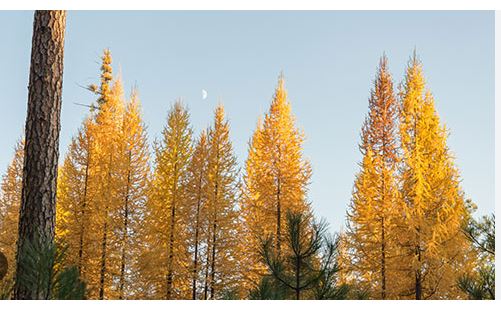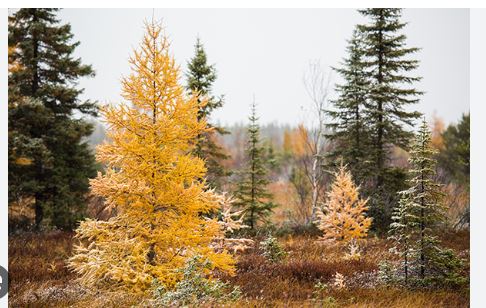
The Tamarack Tree, scientifically known as Larix laricina, belongs to the family Pinaceae, which includes pines, firs, spruces, and other conifers. It is a member of the genus Larix, encompassing larch species known for their deciduous nature, a rare trait among conifers. Larix laricina is commonly referred to as the tamarack, eastern larch, or American larch, distinguishing it from other larches like the European larch (Larix decidua). Its classification places it within the order Pinales, and its deciduous coniferous nature makes it an evolutionary outlier, shedding its needles annually, unlike most evergreen conifers. The species name “laricina” reflects its resinous qualities, derived from the Latin word for larch.
The tamarack has a rich history tied to North American ecosystems and indigenous cultures. Native to the boreal forests of North America, it has been a significant species for thousands of years, particularly for Indigenous peoples such as the Algonquin, who used its roots for sewing canoe bark and its wood for snowshoe frames due to its strength and flexibility. European settlers later adopted tamarack wood for shipbuilding, particularly for “knees” in wooden vessels, owing to its durability. The tree’s ecological role in wetland stabilization and its ability to thrive in harsh conditions made it a keystone species in northern forests. Its fossil record indicates that larches, including tamarack, have existed since the Cretaceous period, adapting to cold climates over millions of years.
Tamarack is a medium-sized tree, typically reaching 40–80 feet in height and 1–2 feet in diameter. It is easily recognized by its deciduous needles, which are soft, light green, and 1–2 inches long, growing in clusters of 10–20 on short spurs. In fall, the needles turn a brilliant golden-yellow before dropping, a striking feature in northern landscapes. The bark is thin, scaly, and reddish-brown, becoming grayish with age. Tamarack produces small, upright cones (0.5–1 inch long) that are light brown with thin scales, persisting on the tree for years. Its slender, open crown and ability to grow in wet soils distinguish it from other conifers like pines or spruces.
Larix laricina is native to North America, with a wide distribution across Canada and the northern United States. It spans from Newfoundland and Labrador west to Alaska, south to Minnesota, Wisconsin, and parts of the northeastern U.S., including northern New York and Maine. Tamarack thrives in cold, wet environments, particularly in bogs, swamps, and poorly drained soils, but it can also grow in upland sites with sufficient moisture. It is a pioneer species, often colonizing open areas after disturbances like fires or flooding. Tamarack plays a critical ecological role in boreal forests, providing habitat for wildlife such as snowshoe hares, porcupines, and birds like the spruce grouse. Its tolerance for acidic, nutrient-poor soils makes it a key species in peatland ecosystems.
Tamarack has diverse practical and ecological uses. Its wood is hard, heavy, and rot-resistant, making it valuable for construction, fence posts, railroad ties, and pulp for paper. Historically, it was prized in shipbuilding and for crafting durable tools. Indigenous peoples used tamarack bark and resin for medicinal purposes, treating ailments like colds and skin conditions. Ecologically, tamarack stabilizes wetland soils, preventing erosion and supporting biodiversity in fragile ecosystems. In landscaping, it is planted for ornamental purposes due to its vibrant fall color and adaptability to wet sites, though it is less common in urban settings. Its needles and cones also provide food for wildlife, enhancing its ecological value.
Tamarack is hardy in USDA Zones 2–5, reflecting its adaptation to cold, northern climates. It thrives in regions with long, cold winters and short, cool summers, tolerating temperatures as low as -50°F. Zone 2 covers areas like central Canada and parts of Alaska, while Zone 5 includes milder regions like southern Ontario and the northern U.S. Great Lakes states. Tamarack is not suited for warmer zones (above Zone 5) due to its need for a cold dormancy period and intolerance of prolonged heat or drought. Its preference for moist, acidic soils further limits its cultivation to specific microclimates within these zones, such as bogs or low-lying areas.

Tamarack Tree (Larix laricina) Cultivation
- Site Selection: Choose a site with full sun exposure, as tamarack thrives in open, bright conditions. It prefers low-lying areas like bogs, swamps, or poorly drained soils but can adapt to well-drained upland sites with consistent moisture.
- Soil Requirements: Tamarack grows best in acidic, moist soils with a pH of 4.0–6.0. It tolerates nutrient-poor, organic soils like peat or muck, common in wetlands, but avoid heavy clay or dry, sandy soils unless supplemented with irrigation.
- USDA Hardiness Zones: Plant in USDA Zones 2–5, where tamarack is hardy. It withstands extreme cold (down to -50°F) but struggles in warmer climates above Zone 5 due to heat intolerance and lack of cold dormancy.
- Watering Needs: Maintain consistent soil moisture, especially during establishment. Tamarack is adapted to wet environments and tolerates standing water, but avoid prolonged drought. Water young trees regularly if rainfall is insufficient.
- Planting Time: Plant in early spring or late fall when the tree is dormant to minimize transplant shock. Bare-root or container-grown saplings are ideal, with spring planting preferred in colder regions to allow root establishment before winter.
- Spacing: Space trees 10–20 feet apart, depending on purpose (e.g., ornamental or reforestation). Tamarack’s slender, open crown allows closer spacing in group plantings, but wider spacing prevents competition in naturalized settings.
- Propagation: Propagate via seeds or cuttings. Seeds require cold stratification (60–90 days at 35–40°F) to break dormancy. Soak seeds for 24 hours before sowing in a moist, well-drained medium. Softwood cuttings can be taken in early summer but root slowly.
- Fertilization: Avoid heavy fertilization, as tamarack is adapted to nutrient-poor soils. If growth is poor, apply a balanced, slow-release fertilizer (e.g., 10-10-10) sparingly in spring. Over-fertilization can harm root systems in boggy soils.
- Pruning: Prune minimally, as tamarack has a natural, open form. Remove dead or damaged branches in late winter or early spring. Avoid heavy pruning, which can stress the tree and disrupt its conical shape.
- Pest and Disease Management: Monitor for pests like larch sawfly, which defoliates needles, and tamarack looper. Apply targeted insecticides if infestations are severe. Fungal diseases like needle cast are rare but can be managed with proper air circulation and avoiding overhead watering.
- Mulching: Apply 2–3 inches of organic mulch (e.g., wood chips or peat moss) around the base to retain moisture and regulate soil temperature. Keep mulch away from the trunk to prevent rot, especially in wet conditions.
- Winter Care: Tamarack is highly cold-tolerant, requiring no winter protection in its hardiness zones. However, protect young trees from browsing animals (e.g., deer, rabbits) using tree guards or fencing, as they may target tender bark in winter.
- Landscape Use: Use tamarack for ornamental purposes in wet gardens, naturalized areas, or reclamation projects. Its golden fall color and tolerance for wet soils make it ideal for rain gardens or near ponds, but it’s less suited for urban or dry landscapes.